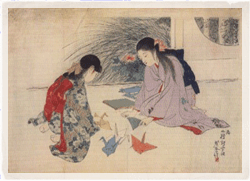|
Origami is Japanese art of paperfolding. "Ori" is Japanese word that means folding and "kami" means paper. |
|

Picture From : http://www.giladori
gami.com/swami/Graphics/girlsfold.gif |
When papermaking methods were developed to be much easier, paper became less expensive. Origami became a popular art for all the riches and the poors. However, Japanese people have always been very careful not to waste anything. They have always saved even the tiniest scraps of paper and used them for folding origami models. |
For centuries there were no written directions for folding origami models because they were orally passed down generations to generations. In 1797, the first written work about origami “How to Fold 1000 Cranes” was published. This book contained the first written set of origami instructions which told how to fold a crane. It was a Japanese custom that if a person folded 1000 cranes, they would be granted one wish.

Picture From : http://www.crazy-frankenstein.com/entertainment-files/story-files/all-about-origami_files/japanese-origami-history.jpg |
Not only were the Japanese folding paper, but the Moors, who were from Africa, and brought paperfolding with them to Spain(called "Pakarita") when they invaded that country in the eighth century. The Moors used paperfolding to create geometric figures because their religion prohibited them from creating animal forms. From Spain, Origami was spread to South America. And when trade routes were developed, the art of origami was introduced to Europe and later the United States. |
Today, master paperfolders can be found in many places around the world. Akira Yoshizawa of Japan is one of these. He is considered the "father of modern origami" because of his creative paperfolding. He also developed a set of symbols and terms that are used worldwidely in written instructions of origami.
| The interest in origami continues to increase today. Like the ancient Japanese, today we found useful purpose in Origami models. Origami will also be a part of our future as we look toward the millennium. The origami crane has become a global peace symbol. |
|
Source : http://library.thinkquest.org/5402/history.html
|



